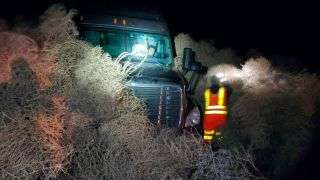
A vehicle can be seen on Tuesday evening (Dec. 31, 2019) after being trapped by a pile of tumbleweeds along State Route 240 near Richland, Washington.
A 30-foot-tall (9 meters) wall of tumbleweed created an odd New Year’s Eve for some drivers near Yakima, Washington, who spent hours trapped on a highway by the roving plants.
State transportation officials had to send out two snowplows to clear the tumbleweeds, which blew onto State Highway 240 in high winds, according to NBC News.
Tumbleweed, sometimes known as Russian thistle, is inextricably linked culturally with the American West, but it’s actually an invader; it’s native to the Ural Mountain steppe in Russia. According to Utah State University, seeds of several closely related tumbleweed plants in the genus first arrived in the United States in flaxseed shipments brought by Russian immigrants to South Dakota in the early 1870s. The plants easily took to the high-and-dry environment of the Plains states and quickly spread across the West. Tumbleweed is also now established in many countries around the world, from New Zealand to Afghanistan.
Tumbleweeds grow up to 3 feet (0.9 m) tall in large bushes. As these bushes mature, they become increasingly spiky and dry. By late summer or autumn, they break off at the stem and sail with the wind, each dropping as many as 250,000 seeds as they travel.
Highway 240 was closed for 10 hours on New Year’s Eve due to such a tumbleweed migration. Five cars and a semitruck got stuck within the plant’s grasp. Photos from the scene show workers dwarfed by the spiny vegetation and cars almost completely buried. According to The Seattle Times, the block of tumbleweed covered an area as long as three football fields.
“In 20 years on the job, I’ve never seen anything like this before,” Washington State Patrol trooper Chris Thorson told the newspaper. “We’ve unofficially dubbed it ‘Tumbleggedon 2020.'”
Winds blowing at speeds of 30 to 50 mph (48 to 80 km/h) transported the tumbleweed.
This isn’t the first time tumbleweeds have created headaches for humans. In April 2018, waves of the weeds besieged the town of Victorville, California, piling up against homes and sometimes blocking second-story windows. That incident was triggered by 60-mph (96 km/h) winds, according to U.S. News & World Report.
Sourse: www.livescience.com





